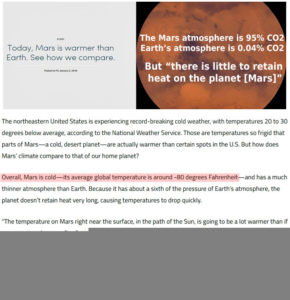by K. Richard, December 2, 2019 in NoTricksZone
Earth’s atmosphere contains 400 ppm CO2 (0.04%). Mars has a 950,000 ppm (95%) CO2 atmosphere. But Mars has surface temperatures that are about -75°C colder on average than Earth’s because atmospheric density, or pressure, is the “game changer” largely determining planetary temperatures.

Surface temperatures on Mars
The average surface temperature of a planetary body is significantly determined by its distance from the Sun.
According to the NASA Jet Propulsion Laboratory, Mars is close enough to the Sun to have its surface temperatures reach 35°C (95°F) at the equator during summer.
During winter, however, the Martian temperature dips to -90°C (-130°F).
The average surface temperature for Mars is about -60°C (-80°F).
…
by The Japan Times, December 2, 2019
WASHINGTON – As world leaders gather in Spain to discuss how to slow the warming of the planet, a spotlight falls on China — the top emitter of greenhouse gases.
China burns about half the coal used globally each year. Between 2000 and 2018, its annual carbon emissions nearly tripled, and it now accounts for about 30 percent of the world’s total. Yet it’s also the leading market for solar panels, wind turbines and electric vehicles, and it manufactures about two-thirds of solar cells installed worldwide.
“We are witnessing many contradictions in China’s energy development,” said Kevin Tu, a Beijing-based fellow with the Center on Global Energy Policy at Columbia University. “It’s the largest coal market and the largest clean energy market in the world.”
That apparent paradox is possible because of the sheer scale of China’s energy demands.
But as China’s economy slows to the lowest level in a quarter century — around 6 percent growth, according to government statistics — policymakers are doubling down on support for coal and other heavy industries, the traditional backbones of China’s energy system and economy. At the same time, the country is reducing subsidies for renewable energy.
…
…
La géologie, une science plus que passionnante … et diverse

